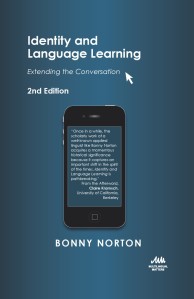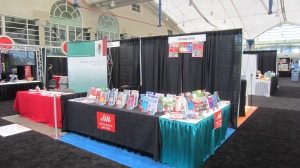This autumn we published the 2nd edition of Bonny Norton’s book Identity and Language Learning. Here, we ask her a few questions about the new edition.
 The first edition of your book Identity and Language Learning was published in 2000. How has the field changed since then and why did you see a need to update the book?
The first edition of your book Identity and Language Learning was published in 2000. How has the field changed since then and why did you see a need to update the book?
As I indicate in the Preface to the second edition, my students at the University of British Columbia encouraged me to bring out my 2000 book as an ebook. I was excited by the idea of making my work more widely accessible – and affordable! This is why the subtitle of the second edition is: “Extending the Conversation”. It was also clear that research on identity and language learning had grown exponentially over the past decade, and that there was a need to locate the earlier research in this wider literature. In the Introduction to the second edition, I update the literature on identity and language learning, including an elaboration of my theory of investment. Issues of imagined identities and imagined communities are also central in this literature review. I have taken the opportunity to address other related areas of interest such as teacher identity, digital identity, and transnational identity. Claire Kramsch’s Afterword places the text in its wider historical context, and is an inspired piece of writing.
How has the term ‘identity’ evolved since the publication of the first edition of your book?
What my 2000 book did was to highlight the ways in which a poststructuralist theory of identity can contribute to an understanding of language learning and teaching. The idea of identity as multiple, changing, and a site of struggle has helped to inform debates on language learning and teaching, and these ideas have gained momentum over time, particularly with emerging scholars. The theory of investment has also helped to inform changing conceptions of motivation in the field, as exemplified in the work of Zoltan Dörnyei and Ema Ushioda.
How then does your theory of investment differ from conventional theories of motivation?
Investment is a sociological construct, while motivation is a psychological construct. This is a very important distinction between the two constructs. The construct of investment helps teachers to understand the relationship between engagement in learning and learner identity. It also highlights the ways in which relations of power might impact social interaction in classrooms and communities, both virtual and face-to-face. For example, a teacher might have a seemingly unmotivated student who doesn’t participate or talk in class. But if the student, for example, is a good guitar player, the teacher could say, “let’s have a jam session and play some music.” The student’s identity then shifts from ‘unmotivated student’ to ‘musician’, and the student becomes more engaged in the activities of the classroom. The student may have always been motivated to learn, but not necessarily invested in the language practices of that particular classroom. Because of the jam session, the relationship between the student and the class changes, and the student begins talking with greater comfort and ease. The identity ‘musician’ gives the student more power in the classroom.
Can you elaborate on how investment relates more specifically to teacher identity?
To consider a different scenario: there may be a disjuncture between what the teacher (or school) considers good teaching, and what particular students (or their families) consider good teaching. Such a disjuncture may arise from different cultural traditions with respect to pedagogical practice, and what are perceived to be productive relationships between teaching and learning. For this reason, it is helpful for the teacher to ask not only, “Why is this student not motivated to learn?” but also, “Why is this student not invested in the language practices of my classroom?” The construct of investment assumes that both learners and teachers are central in the learning process, which is open to negotiation and change. How can teachers ensure that students are invested in the language practices of their classrooms? The most important challenge for the teacher is to promote practices that validate student identity and encourage student investment.
Does your future research address issues of identity?
Any research that includes human participants will have implications for theories of identity and investment, and this includes questions of researcher identity. Like many scholars in the field of language education, one of my identities is that of a transnational citizen, having been brought up in South Africa, had children in the USA, worked in Canada, and done years of research in Uganda. Over the next few years, I will be active in the groundbreaking African Storybook Project, an initiative of the South African Institute for Distance Education (see http://www.saide.org.za/african-storybook-project). This project draws on advances in digital technology to promote the multilingual literacy of children in sub-Saharan Africa. Open access digital stories, in multiple languages, are currently being developed for the three pilot countries of South Africa, Uganda, and Kenya. The stories are being uploaded on a comprehensive website, available for use not only in Africa, but also in the wider international community. As research advisor on this project, I’m helping to set up a research network that will advance the goals of the African Storybook Project. As learners, teachers, and communities engage in innovative ways with digital stories, there will likely be important shifts in both teacher and student identity. It’s a very exciting project, with huge implications for the future. Check out the 10-minute YouTube video at: http://www.youtube.com/watch?v=Rc-qjmdetp8&feature=youtu.be
You can find more information about Bonny’s book on our website.












